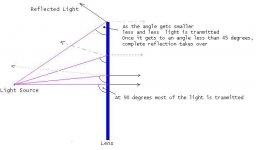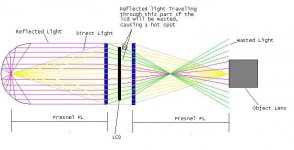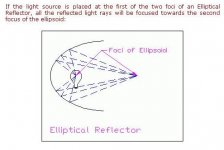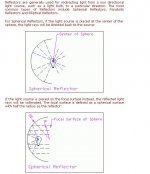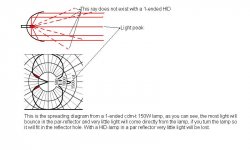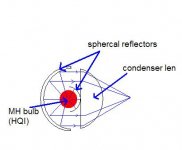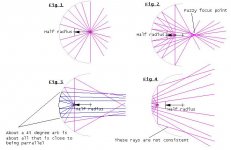Hello Ace,
Please don’t take this as an attack on your knowledge or a ‘I know more than you’ game, it’s purely for understanding what is happening in the light path, as you probably know more than I do. Feel free to criticise any of my theories, but not too much, I’m a bit sensitive.
I agree that light that travels further is less intense but there are other factors to consider as well.
The angle of incidence the light hits the lens. Light that doesn’t hit the lens at 90 degrees will be partially reflected, the smaller the angle the greater the reflected light. This affect is exaggerated when we use large LCD’s. If we could only get an optical coating for our fresnal's. (See pic1)
Light that doesn’t enter the light path at the right angle will cause multiple focused light points in front of the fresnels. This is where spherical reflectors work well as you said in an earlier post. (See pic2)
You could move the object lens a bit closer and adjust the lamp to fresnel distance to get an improvement.
Another potential problem could be polarised light from the reflector, but this is getting a little to complex for me to understand just yet.
I also agree that elliptical reflectors are the way to go, would you happen to have any good sites that explain the theory behind these. (What shapes, sizes, distances, determines the focal points)
DJ
Please don’t take this as an attack on your knowledge or a ‘I know more than you’ game, it’s purely for understanding what is happening in the light path, as you probably know more than I do. Feel free to criticise any of my theories, but not too much, I’m a bit sensitive.
I agree that light that travels further is less intense but there are other factors to consider as well.
The angle of incidence the light hits the lens. Light that doesn’t hit the lens at 90 degrees will be partially reflected, the smaller the angle the greater the reflected light. This affect is exaggerated when we use large LCD’s. If we could only get an optical coating for our fresnal's. (See pic1)
Light that doesn’t enter the light path at the right angle will cause multiple focused light points in front of the fresnels. This is where spherical reflectors work well as you said in an earlier post. (See pic2)
You could move the object lens a bit closer and adjust the lamp to fresnel distance to get an improvement.
Another potential problem could be polarised light from the reflector, but this is getting a little to complex for me to understand just yet.
I also agree that elliptical reflectors are the way to go, would you happen to have any good sites that explain the theory behind these. (What shapes, sizes, distances, determines the focal points)
DJ
Attachments
Heya Daz, no argument here bud, ive coverd basically the first half of why we get a hot spot, and you've coverd the second, nice post's, and i agree with you on what your saying. Lets hope others can learn from this and we can go forward and get ahead in making a more so perfect projector.
Frensels do carry a small amount of anti glare properties in their materials, but realisticly this isnt enough, im just courious if 3m make an optical anti glare film that we could stick onto the first frensel to hep get more light through it.
The condenser im using and others too soon no doubt has a very strong anti glare coating on it, i have also the same condenser without that anti glare coating, and boy, you can realy tell the difference between the 2. The one with the anti glare realy does get a whole lot more light through it rather then it being reflected, i think all we need now is a coating similar or if not the same in a film form to stick onto our rear frensel. If we manage to find a good enough film, we could even use this to cover the back of our projection lens with it.
Trev
Frensels do carry a small amount of anti glare properties in their materials, but realisticly this isnt enough, im just courious if 3m make an optical anti glare film that we could stick onto the first frensel to hep get more light through it.
The condenser im using and others too soon no doubt has a very strong anti glare coating on it, i have also the same condenser without that anti glare coating, and boy, you can realy tell the difference between the 2. The one with the anti glare realy does get a whole lot more light through it rather then it being reflected, i think all we need now is a coating similar or if not the same in a film form to stick onto our rear frensel. If we manage to find a good enough film, we could even use this to cover the back of our projection lens with it.
Trev
I also agree that elliptical reflectors are the way to go, would you happen to have any good sites that explain the theory behind these. (What shapes, sizes, distances, determines the focal points)
Hmm these things can be a pain to try and figure out, there are also only a handfull of places to buy them in certain foramts, ie: first and second focal to diameter ratio. Basically how these work is the wider the diameter the longer the second focal will be.
Here is a pic of an eliptical reflector system curtisy of A.W.I industries.
Trev
Attachments
Just a little correction regarding Parabolic-reflector with HID lamps. I have written this before but it doesn´t hurt writing it again.
A HID-lamp have a different spreading diagram than a normal halogen lamp, it doesn´t spread the light even in all direction. If you place a 1-ended HID (HQI,cdm-t,mh) in a par-reflector and turn the lamp in the way so you use the hole in the reflector for the lamp, very little light is coming directlty from the lamp, the most light will bounce in the par-reflector. If you see a hot spot with a 1-ended HID-lamp in a par reflector it´s probably because the HID-lamp has a very strong light peak from the front of the lamp (see my picture) or you have just not placed the lamp right in the reflector. You must turn a HID-lamp right in a Par-reflector this is why it´s very hard to use a double-ended lamp in a Par-reflector.
The Par-reflector is very effective with a HID-lamp because of the HID-lamps special lightspreading diagram, with a halogen lamp you can say that you waste some light but not with a HID-lamp.
Almost all Pro-projectors use either parabolic or eliptical-reflector because those are most effective with HID-lamps. 3 panel lcd projectors use parabolic-reflector and two strong condensorlenses after that, this give almost 100% light uniformity.
A HID-lamp have a different spreading diagram than a normal halogen lamp, it doesn´t spread the light even in all direction. If you place a 1-ended HID (HQI,cdm-t,mh) in a par-reflector and turn the lamp in the way so you use the hole in the reflector for the lamp, very little light is coming directlty from the lamp, the most light will bounce in the par-reflector. If you see a hot spot with a 1-ended HID-lamp in a par reflector it´s probably because the HID-lamp has a very strong light peak from the front of the lamp (see my picture) or you have just not placed the lamp right in the reflector. You must turn a HID-lamp right in a Par-reflector this is why it´s very hard to use a double-ended lamp in a Par-reflector.
The Par-reflector is very effective with a HID-lamp because of the HID-lamps special lightspreading diagram, with a halogen lamp you can say that you waste some light but not with a HID-lamp.
Almost all Pro-projectors use either parabolic or eliptical-reflector because those are most effective with HID-lamps. 3 panel lcd projectors use parabolic-reflector and two strong condensorlenses after that, this give almost 100% light uniformity.
Attachments
Heya Mathias, long time no see, good to see u up here. 🙂
Firstly im going to say ( dont take it in any bad way🙂 ) that the rays that you have said that dont exist do, the chart that shows the light spead of the cdm-t bulb is only the peak light pattern, this is meaning that the brightest light from the bulb comes from those dirrections, its impossible to say that other rays dont exist unless the light is housed in somthing to dirrect the light only in that pattern, ie: a reflector. An open source will always send light out in all dirrections, but depending on the manufactures design intentions they can design a lamp to projuce more light in one dirrection then another as we can clearly see with your attached chart.
Another thing with parabolics is the fact that if you dont get your lamp right at its focal, you will get very different results. Having the lamp too far in the reflector and the center of the image becomes dim, having the light too far out of the reflector and the outer parts of the image are dim, having it right at the focal gives us a much more even light, though the center is always brighter then the outer edges of the image, ( hot spot). Now some are probally going to think, why not try to ballance it so the light is even?, well sorry guys you cant, ive tried and you cant get it spot on to where we want it to be as we will always have the hot spot, or the dim center, we also want our light to be paralelle. 1mm also makes the world of difference in these reflectors, that just gives you an idea on just how sensitive reflectors are.
Mathias, i do think that there is a cure for this hot spot, or atleast somthing that helps, take a look at a comercial metal halide and what do you see on the end of the arc tube? white paint. This would help the hot spot issue coming from the end of the bulb. Im tempted to try it out on my cdm-t but at this stage, ive found a brighter solution thats about 4x smaller and gives better results.
Trev🙂
Firstly im going to say ( dont take it in any bad way🙂 ) that the rays that you have said that dont exist do, the chart that shows the light spead of the cdm-t bulb is only the peak light pattern, this is meaning that the brightest light from the bulb comes from those dirrections, its impossible to say that other rays dont exist unless the light is housed in somthing to dirrect the light only in that pattern, ie: a reflector. An open source will always send light out in all dirrections, but depending on the manufactures design intentions they can design a lamp to projuce more light in one dirrection then another as we can clearly see with your attached chart.
Another thing with parabolics is the fact that if you dont get your lamp right at its focal, you will get very different results. Having the lamp too far in the reflector and the center of the image becomes dim, having the light too far out of the reflector and the outer parts of the image are dim, having it right at the focal gives us a much more even light, though the center is always brighter then the outer edges of the image, ( hot spot). Now some are probally going to think, why not try to ballance it so the light is even?, well sorry guys you cant, ive tried and you cant get it spot on to where we want it to be as we will always have the hot spot, or the dim center, we also want our light to be paralelle. 1mm also makes the world of difference in these reflectors, that just gives you an idea on just how sensitive reflectors are.
Mathias, i do think that there is a cure for this hot spot, or atleast somthing that helps, take a look at a comercial metal halide and what do you see on the end of the arc tube? white paint. This would help the hot spot issue coming from the end of the bulb. Im tempted to try it out on my cdm-t but at this stage, ive found a brighter solution thats about 4x smaller and gives better results.
Trev🙂
Hi Ace,
My thoughts were that "your" optical design, like the pyramid, won't deliver any good results. I just wanted that to be confirmed by pictures of your projections. Unfortunatly there are none.
However, finally you are making some progress by thinking about the light rod.
My thoughts were that "your" optical design, like the pyramid, won't deliver any good results. I just wanted that to be confirmed by pictures of your projections. Unfortunatly there are none.
However, finally you are making some progress by thinking about the light rod.
My thoughts were that "your" optical design, like the pyramid, won't deliver any good results.
Hi Yoshi, why? explain. I find that quite a remark considering you dont know the full layout or specs of the optics in the light engine design.
If you had of read one of my last posts from some time ago i dont rely on the pyramid to guide light to the lcd anymore, i use a 2 condenser system instead wich is much more acurate as in lighting is concernd. The pyramid in this design is used to block light, recycle reflected light, and not to not reflect it any longer to the lcd. And hands down, pyramids relyed on or not to guide light do work, but they have to be designed right for the purpose they are designed for, therfore i dont recomend in using one to be relyed on to guide light to the lcd, optics are far more acurate and give us the ultimate result.
I just wanted that to be confirmed by pictures of your projections. Unfortunatly there are none
You got a spare $300 for a cam thats decent enough to take acurate screen shots for me? Im also going to ask, why should i have to spend $300 on cam just to show you the screen shot when im not going to use the cam for anything else? Kind of a waste if you ask me, id rather spend that cash on R&D. If you have fooled around with projectors long enough, and did some hands on R&D, then you will fully understand how they work and what to expect in different configerations, screen shot or not. I will buy a cam as soon as i have the money, right now im more interested in getting the best out of projection and getting this thing done. If you want to see screen shots of a pojector that uses a pyramid then search for crusers bumble bee thread.
However, finally you are making some progress by thinking about the light rod.
Light rod? dont you mean the light guide? or are you on about the rod reflector? both are old news and are well known, its all over the net, ill also add light guides arent so good for our systems, not unless you want to buy a 7inch triplet, atleast for the light guide that im talking about.
I find your post quite rude and insulting, maybe if you did alittle R&D yourself, then maybe you would see the benifts yourself in your own projector rather then relying on someone elses results.
If you wasnt intentionaly rude, forgive my last post.
Trev
quote:
Hi Ace,
I have to admit that I was a bit intentionally rude to provoke pictures. Sadly, didn't work. Instead, you may felt hurt. I'm sorry and appologize for crossing the line.
I acknowledge all the work you are doing here. This thread and your design inspired me to build a DIY-Beamer, thank you.
Theres is no excuse to make, I missed to read your update and the new design with 2 condensors instead of pyramid which causes to stray light in my opinion.
quote:
I wish I had the bucks for you and we the pics of your projection. Feeling really guilty now to have provoked you while you are justifying yourself, sorry again. Keep up the R&D and you took the right decision to invest the money there. Ironically, I'm in the same situation as you. I'm also spending money in several parts and doing experiments instead buying a nice cam.
I find your post quite rude and insulting, maybe if you did alittle R&D yourself, then maybe you would see the benifts yourself in your own projector rather then relying on someone elses results.
If you wasnt intentionaly rude, forgive my last post.
Hi Ace,
I have to admit that I was a bit intentionally rude to provoke pictures. Sadly, didn't work. Instead, you may felt hurt. I'm sorry and appologize for crossing the line.
I acknowledge all the work you are doing here. This thread and your design inspired me to build a DIY-Beamer, thank you.
Theres is no excuse to make, I missed to read your update and the new design with 2 condensors instead of pyramid which causes to stray light in my opinion.
quote:
You got a spare $300 for a cam thats decent enough to take acurate screen shots for me? Im also going to ask, why should i have to spend $300 on cam just to show you the screen shot when im not going to use the cam for anything else? Kind of a waste if you ask me, id rather spend that cash on R&D.
I wish I had the bucks for you and we the pics of your projection. Feeling really guilty now to have provoked you while you are justifying yourself, sorry again. Keep up the R&D and you took the right decision to invest the money there. Ironically, I'm in the same situation as you. I'm also spending money in several parts and doing experiments instead buying a nice cam.
Light rod? dont you mean the light guide? or are you on about the rod reflector? both are old news and are well known, its all over the net, ill also add light guides arent so good for our systems, not unless you want to buy a 7inch triplet, atleast for the light guide that im talking about.
[/qoute]
Hmmm...,I meant the light guide you spoke about a few posts ago. Maybe I misunderstood you. I'm aware that those are all known and I'm sure if there will be any new things, it wouldn't be
published here first.
I'll end with a further apology and thanks again for inspiring me and others.
sorry for jumping in,
but here is a light engine designed by automotive maufactures. The theory is to use two spherical reflector to collect all the light rays.
-a small reflector near the bulb to recycle the light rays.
-a large reflector to direct the light rays out to the condenser.
this system is at least 90% efficient, but...does it causes any cut off or hot spot problems?
PS: I can CNC the two required reflectors to exact specification if the theory holds.
but here is a light engine designed by automotive maufactures. The theory is to use two spherical reflector to collect all the light rays.
-a small reflector near the bulb to recycle the light rays.
-a large reflector to direct the light rays out to the condenser.
this system is at least 90% efficient, but...does it causes any cut off or hot spot problems?
PS: I can CNC the two required reflectors to exact specification if the theory holds.
Attachments
Here is a pic that shows the affect of different lamp positions for a spherical reflector Note that this pic only shows the reflected light, the direct light introduces another set of problems.
As you can see we can produce a wide variety of beam shapes. Each one of these lamp positions with the exception of fig 1 isn’t perfect.
In Fig 2 the focus point is not really focused.
In Fig 3 the light not quite parallel.
In Fig 4 the smaller angle of incidence rays don’t spread out consistently.
This shows the basic principals of a spherical reflector and it also shows its limitations. As Ace said in a earlier post in this thread that’s why different types of reflector are for different purposes, an elliptical is good for focusing and a parabolic is good for parallel and spreading. Once we understand the limitations of each we might be able to design one that better suits our needs
Ace please let me know if you think I’m hijacking your thread.
DJ.
As you can see we can produce a wide variety of beam shapes. Each one of these lamp positions with the exception of fig 1 isn’t perfect.
In Fig 2 the focus point is not really focused.
In Fig 3 the light not quite parallel.
In Fig 4 the smaller angle of incidence rays don’t spread out consistently.
This shows the basic principals of a spherical reflector and it also shows its limitations. As Ace said in a earlier post in this thread that’s why different types of reflector are for different purposes, an elliptical is good for focusing and a parabolic is good for parallel and spreading. Once we understand the limitations of each we might be able to design one that better suits our needs
Ace please let me know if you think I’m hijacking your thread.
DJ.
Attachments
Ace please let me know if you think I’m hijacking your thread.
Heya Daz, not at all, keep it comming🙂, we can never know too much.
In your pic 3, in a way it is right and in a way it is wrong, it is right for that shape of spherical but for a low profile spherical the light can be paralelle providing its the right shape and or focal lengnth, ahhh, hard to explain, just being picky lol nothing aimed at you 🙂.
The best way to put it is the spherical that you and imo i have drawn over times is a half of a sphere, where as a low profile spherical is normally 1/8 - 1/12 of a sphere being very flat with having the low distortion because of its shape, that also regards the focal. By me saying shape im not saying that the shapes differ but what i mean is how much of a sphere the reflector is acually designed from and what size the sphere is.
Talking of focal, if we have a spherical with a very short focal we can also get very undesirable results, and the shorter the focal, the closer also the condenser ( also larger) must be to the lamp to capture the reflected light at that wider angle. The biggest problem i find with reflectors and its probally the most important part to reflectors in a particular system, is the angle of the reflected rays going through the system right from the source. If the focal is wrong you will loose light weather the lamp is at the reflectors focal or not, add heat to surrounding components, and the light will be distorted to all of the other light engine optics.
Another thing is that the lamps we use for diy projection have arcs that are far too big, this aplies to any reflector or configeration that we currently use with our bulbs. The ideal arc size would be 1 micron, heh impossible in todays world, relisticly 1mm is fine for what we need, pro projectors arcs are typical of 2-3mm in size, the smallest we have is 10mm. The bigger the arc, the more inacurate our reflected light will be thus causing distortion, and thats why i sujested the barrel or rod reflector for our type of bulbs.
Trev 🙂
Faites777 said:sorry for jumping in,
but here is a light engine designed by automotive maufactures. The theory is to use two spherical reflector to collect all the light rays.
-a small reflector near the bulb to recycle the light rays.
-a large reflector to direct the light rays out to the condenser.
this system is at least 90% efficient, but...does it causes any cut off or hot spot problems?
PS: I can CNC the two required reflectors to exact specification if the theory holds.
Heya faites, yeah they are great systems, its actually a spherical and a parabolic system, though as great as they maybe for illuminating a wall, if we wer to try to focus a dual frensel to that, the frensel would focus to the back of the center spherical reflector and probally cause us to have a dead spot in the center of the image, or a dim image. Also running paralelle rays to a dual frensel system is no good because the light rays are at the incorrect angle, this isnt rulling out that idea because if you have just the 1 frensel, with the rings facing the light, then the paralelle light rays are at the correct angle to that frensel, and it should work as we arnt focusing to a point.
Trev😉
I have to admit that I was a bit intentionally rude to provoke pictures. Sadly, didn't work. Instead, you may felt hurt. I'm sorry and appologize for crossing the line.
No problem, just remember you cant get blood out of a stone!
Keep up the R&D and you took the right decision to invest the money there. Ironically, I'm in the same situation as you. I'm also spending money in several parts and doing experiments instead buying a nice cam.
Great to hear!, if we all put our heads together, spend alittle bit of cash, and do some R&D, our results will follow higher then expected. Results always come last, it will depend on how much time and effort we put into anything to get the end result we all desire.
Theres is no excuse to make, I missed to read your update and the new design with 2 condensors instead of pyramid which causes to stray light in my opinion.
If your talking about the pyramid straying light, your 100% correct, that can be iliminated somwhat through a carfully designed pyramid not just a strait angled one like most, if not all are using. The dual condenser setup is the way to go, i wouldnt turn back.
No probs on the being rude, im glad that you can admit being rude, and have been honest and come forward with it, lets forget about that 🙂 and get onto some advanced R&D research!🙂
Trev 🙂
have you got a websight ace
Not yet bud, will be up again real soon with a forum.
Trev
me two cents..
Wow!
I missed a lot damned exams!!!
1.
Anyways.. I just wanted to say that the rod / barrel reflector idea is kinda familiar .. isnt that used in flood lights for peoples front proches?
2.
I also waned to say that there is a linnk in the wiki for a polorised light recycler I cant recall how it actually worked.. but it maybe the answer to sorting out stray light… heres the link if you don’t know about it.
3. ACE.. you mantioned that the shperical reflector can behave a sa parabolic if the source light is mo
ved about.. as far as I know the Spherical refelctors focal point is 1/2 the radius.. so where do you put the light????
4.
The figure two given by dazzla can be corrected to give a defined focal point.. I think you need to put a disc ..a reflective disc areound the edge of the spherical reflector to remove the abberitiopn.. correct me if im wrong.. I can remember where I got this from but I know that’s the answer..
Sorry about not easing into things like I do but im busy as heck..
Sorry people!.
Wow!
I missed a lot damned exams!!!
1.
Anyways.. I just wanted to say that the rod / barrel reflector idea is kinda familiar .. isnt that used in flood lights for peoples front proches?
2.
I also waned to say that there is a linnk in the wiki for a polorised light recycler I cant recall how it actually worked.. but it maybe the answer to sorting out stray light… heres the link if you don’t know about it.
3. ACE.. you mantioned that the shperical reflector can behave a sa parabolic if the source light is mo
ved about.. as far as I know the Spherical refelctors focal point is 1/2 the radius.. so where do you put the light????
4.
The figure two given by dazzla can be corrected to give a defined focal point.. I think you need to put a disc ..a reflective disc areound the edge of the spherical reflector to remove the abberitiopn.. correct me if im wrong.. I can remember where I got this from but I know that’s the answer..
Sorry about not easing into things like I do but im busy as heck..
Sorry people!.
me two cents..
Wow!
I missed a lot damned exams!!!
1.
Anyways.. I just wanted to say that the rod / barrel reflector idea is kinda familiar .. isnt that used in flood lights for peoples front proches?
2.
I also waned to say that there is a linnk in the wiki for a polorised light recycler I cant recall how it actually worked.. but it maybe the answer to sorting out stray light… heres the link if you don’t know about it.
http://www.nasatech.com/Briefs/June01/NPO20824.html
what do you think ACE.. applicable for our projectors?
3. ACE.. you mentioned that the shperical reflector can behave as a parabolic if the source light is moved about.. as far as I know the Spherical refelctors focal point is 1/2 the radius.. so where do you put the light????
4.
The figure two given by dazzla can be corrected to give a defined focal point.. I think you need to put a disc ..a reflective disc areound the edge of the spherical reflector to remove the abberitiopn.. correct me if im wrong.. I can remember where I got this from but I know that’s the answer..
ahh here it is!;
http://www.glenbrook.k12.il.us/gbssci/phys/Class/refln/u13l3g.html
Sorry about not easing into things like I do but im busy as heck..
Sorry people!.
Wow!
I missed a lot damned exams!!!
1.
Anyways.. I just wanted to say that the rod / barrel reflector idea is kinda familiar .. isnt that used in flood lights for peoples front proches?
2.
I also waned to say that there is a linnk in the wiki for a polorised light recycler I cant recall how it actually worked.. but it maybe the answer to sorting out stray light… heres the link if you don’t know about it.
http://www.nasatech.com/Briefs/June01/NPO20824.html
what do you think ACE.. applicable for our projectors?
3. ACE.. you mentioned that the shperical reflector can behave as a parabolic if the source light is moved about.. as far as I know the Spherical refelctors focal point is 1/2 the radius.. so where do you put the light????
4.
The figure two given by dazzla can be corrected to give a defined focal point.. I think you need to put a disc ..a reflective disc areound the edge of the spherical reflector to remove the abberitiopn.. correct me if im wrong.. I can remember where I got this from but I know that’s the answer..
ahh here it is!;
http://www.glenbrook.k12.il.us/gbssci/phys/Class/refln/u13l3g.html
Sorry about not easing into things like I do but im busy as heck..
Sorry people!.
ACE.. you mentioned that the shperical reflector can behave as a parabolic if the source light is moved about.. as far as I know the Spherical refelctors focal point is 1/2 the radius.. so where do you put the light????
Haya bal, most sphericals have a 0.5 focal, you have to get a spherical that has a focal of 1.0 factor.
Example of 0.5 factor
50mm dia 25mm focal
Example of 1.0 factor
50mm dia 50mm focal
I have a 1.0 focal factor precision spherical here, i run it at half of its r2 radious to get the focal for running it as a paralelle reflector. To see if its paralelle just use your eyes and look into the reflector close up, and then from a distance, you should see the exact same in the reflector of the bulb close up as what you do far away, if its out, the arc will become smaller in the reflector meaning its not paralelle. If we use a 0.5 focal factor reflector, the focal of those reflectors becomes too short along with the added distortion, its also very inefficient to our beam pattern from our light as the bulbs just too close in all areas for it to work properly. If you get a precision spherical reflector with the focal factor of 1.0, do the maths, it works every time with great results.
The figure two given by dazzla can be corrected to give a defined focal point.. I think you need to put a disc ..a reflective disc areound the edge of the spherical reflector to remove the abberitiopn.. correct me if im wrong.. I can remember where I got this from but I know that’s the answer..
That can be done but i dont recomend it, it can give us unwanted results depending on our arcs size and reflector size, also the arcs beam pattern. This is because light will reflect from that disc no matter the colour, matt black or not, and will give us scatterd light from the top of the disk. The biggest problems we all face is the actual size of our arc, until we can get a 1-3mm arc size in our projectors we cant exspect perfect results.
Anyways.. I just wanted to say that the rod / barrel reflector idea is kinda familiar .. isnt that used in flood lights for peoples front proches?
Na they are abit differnt bud lol, ill draw a pic of one soon.
Trev🙂
- Status
- Not open for further replies.
- Home
- General Interest
- Everything Else
- The Moving Image
- DIY Projectors
- Ace_3000....pictures of Projector?
